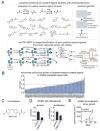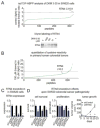Chemoproteomics-enabled covalent ligand screen reveals a cysteine hotspot in reticulon 4 that impairs ER morphology and cancer pathogenicity
- PMID: 28352901
- PMCID: PMC5491356
- DOI: 10.1039/c7cc01480e
Chemoproteomics-enabled covalent ligand screen reveals a cysteine hotspot in reticulon 4 that impairs ER morphology and cancer pathogenicity
Abstract
Chemical genetics has arisen as a powerful approach for identifying novel anti-cancer agents. However, a major bottleneck of this approach is identifying the targets of lead compounds that arise from screens. Here, we coupled the synthesis and screening of fragment-based cysteine-reactive covalent ligands with activity-based protein profiling (ABPP) chemoproteomic approaches to identify compounds that impair colorectal cancer pathogenicity and map the druggable hotspots targeted by these hits. Through this coupled approach, we discovered a cysteine-reactive acrylamide DKM 3-30 that significantly impaired colorectal cancer cell pathogenicity through targeting C1101 on reticulon 4 (RTN4). While little is known about the role of RTN4 in colorectal cancer, this protein has been established as a critical mediator of endoplasmic reticulum tubular network formation. We show here that covalent modification of C1101 on RTN4 by DKM 3-30 or genetic knockdown of RTN4 impairs endoplasmic reticulum and nuclear envelope morphology as well as colorectal cancer pathogenicity. We thus put forth RTN4 as a potential novel colorectal cancer therapeutic target and reveal a unique druggable hotspot within RTN4 that can be targeted by covalent ligands to impair colorectal cancer pathogenicity. Our results underscore the utility of coupling the screening of fragment-based covalent ligands with isoTOP-ABPP platforms for mining the proteome for novel druggable nodes that can be targeted for cancer therapy.
Figures





References
-
- Smukste I, Stockwell BR. Annu Rev Genomics Hum Genet. 2005;6:261–286. - PubMed
MeSH terms
Substances
Grants and funding
LinkOut - more resources
Full Text Sources
Other Literature Sources
Medical

